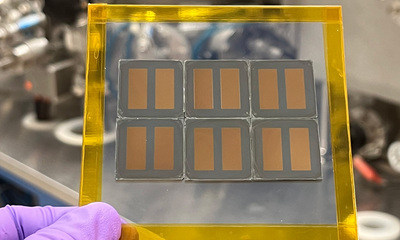New strategy boosts perovskite solar cell efficiency

Perovskite solar cells are a promising alternative to silicon-based photovoltaic technologies; however, their widespread adoption is limited by poor environmental stability, as perovskite materials can degrade easily when exposed to oxygen, moisture, heat or light. Now, researchers from Nanyang Technological University, Singapore (NTU Singapore) have used chemically inert materials to improve the stability of perovskite solar cells.
The research was published in Nature Energy and led by Professor Sum Tze Chien, Director of the Institute of Advanced Studies at NTU Singapore.
To protect perovskite solar cells from environmental degradation, an ultrathin interface layer typically made of highly reactive bulky cations — large positively charged ions — is applied to the perovskite film. Although the cations readily react with perovskites to form a coating that provides good electrical conductivity, such interface layers have low stability due to their reactivity.
On the other hand, chemically inert bulky cations can be integrated into the interface layers to produce a protective coating that offers both high stability and good electrical conductivity. However, this integration is limited by the low reactivity of such cations.
To overcome this challenge, the NTU team developed a strategy called selective templating growth (STG) to create chemically inert interface layers that combine high stability with good conductivity.
In this strategy, the team first deposited a layer of phenylammonium lead iodide (PA2PbI4) onto the perovskite surface. PA2PbI4 is usually used to protect the underlying perovskite layer to improve the performance of perovskite solar cells.
Then, a chemically inert bulky cation — 2-piperidin-1-ium-1-ylethylammonium (PiEA2+) — was introduced by spin-coating an alcohol-based PiEA2+ solution onto the PA2PbI4 layer. Through a controlled organic cation exchange process, in which PA+ is replaced by PiEA2+, a more stable ultrathin layer of (PiEA)PbI4 is formed.
“Our strategy enables access to a class of chemically inert interface materials that previously could not be used due to reactivity and solubility limitations, opening a new avenue for interface engineering in perovskite devices,” Sum said.
Using the strategy, the team fabricated a 1 cm2 perovskite solar cell prototype that achieved a power conversion efficiency of 25.1%, reportedly one of the highest reported for perovskite solar cells of this size. The device retained over 93% of its initial efficiency after 1000 hours of operation, and 98% after 1100 hours at 85°C.
Beyond the prototype (PiEA)PbI4 interface, the strategy also enables the formation of a wide variety of chemically inert interfaces. Importantly, being fully solution-based, the approach is compatible with industrial techniques for coating large areas, such as blade-coating, paving the way for large-scale fabrication and practical deployment.
The new strategy could also be extended to the manufacturing of lead-free perovskite solar cells, as well as other perovskite optoelectronic devices such as light-emitting diodes and photodetectors.
Predictive AI model enhances solid-state battery design
ECU researchers are working on ways to make solid-state batteries more reliable with the help of...
Boosting performance of aqueous zinc–iodine batteries
Engineers from the University of Adelaide have enhanced aqueous zinc–iodine batteries using...
Sodium-ion battery breakthrough boosts energy storage
Scientists have discovered that leaving water inside a key material, rather than removing it,...






